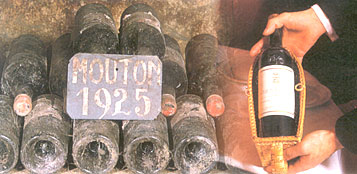

One of the greatest areas of wine mystery and mystique is the difference between vintages. Was 1990 a good year for Chateauneuf-du-Pape? When ought I to drink my 1989 claret? Which was better for red Burgundy – 1990 or 1993?
Unfortunately, the closer you look at vintages, the more confusing the subject tends to become; if you want a simple, reliable, easy-to-follow vintage chart that will fit on the back of a credit car, I’m afraid that you are out of luck. If, on the other hand, what you are looking for is good flavour and god value, you’ve come to the right place – because it’s surprising how often the best buys are to be found in years that get the cold shoulder from most vintage charts. The chart on the following pages is different because it looks at drinkability – the readiness of the wine to be enjoyed – as well as quality.
When thinking about vintages, it is worth bearing the following points in mind:
· “Great” vintages aren’t always the ones you want to buy - particularly if the wines are young and you are going to open them son. Many “lesser” vintages – such as 1987, 1992 and 1993 for red Bordeaux – are much more enjoyable when they are only a few years old, at an age at which “better” ones – such as 1986, 1988 or 1990 – are not yet ready to drink.
· The quality of a vintage – or lack of it – is only partly dependent on the weather during the summer. The clock begins ticking in the spring when the first leaves appear on the vines, and continues right up until the moment when the last grapes are safely picked and carried into the winery. A spring frost can harm the vines; bad weather at the flowering in the early summer can cut down the size of the crop; rain coupled with warm weather in the summer may lead to rot developing on the fruit; cold temperatures at summer’s end may prevent the grapes from ripening properly; storms during the harvest may dilute the wine; hail can tear the bunches from the vines.
· Weather conditions can vary widely within the same country and even region. So, a great year for Burgundy in the east of France may be a rotten one for Bordeaux, down in the south-west. Chablis can have markedly better weather than Chassagne-Montrachet, 100 miles further south – despite the fact that both are usually given the same “White Burgundy” rating on most vintage charts.
· Different grape varieties react in different ways. In Bordeaux, for example, the Merlot – which is the predominant grape in St Emilion and Pomerol – ripens earlier than the Cabernet Sauvignon, which is the main variety in the Medoc. So, in years like 1964, when rainstorms ruined the harvest in the Medoc, the Merlot grapes of the former areas had already been picked in perfectly dry weather.
· Similarly, the varieties used to make Sauternes and Barsac need damp weather to develop noble rot – the very same damp weather that can cause havoc in neighbouring vineyards where the grapes for dry red wine are grown. Both 1967 and 1965, which were disastrous years for claret, produced stunning Chateau d’Yquem. Great years for white Burgundy – 1973, 1979, 1982 and 1986 – are often less impressive for red, partly because the Chardonnay is happier than the Pinot Noir in cooler weather, and partly because, unlike that variety, it has the capacity to produce good wine in heavily productive vintages.
· Wine-makers can get it right in bad years – and wrong in good ones. A week’s holiday taken during the crucial week when neighbouring growers discover they have to spray against rot can make all the difference between making great wine and poor, rotty stuff. Similarly, growers who do not prune tightly enough can allow their vines to over-produce in potentially good vintages and will make thin, dilute wine. If the weather during the harvest is too hot, wine-makers who do not have cooling equipment can see their fermenting vats overheat and their wine irredeemably spoiled.
On the other hand, in rainy years, richer wine-makers can use sophisticated cryoextraction systems to freeze grapes and remove water from the juice and consequently to produce more concentrated wines. Even when not using such new-fangled methods, producers such as the owners of the smarter chateaux in Bordeaux can, in any case, afford to omit all but their best wine from the bottles which will carry the chateau name. Which helps to explain why, say, in the rainy years of 1992 and 1993 big-name clarets were comparable to those from better, drier vintages while smaller producers made stuff which was downright unacceptable.Next
|
|
|



